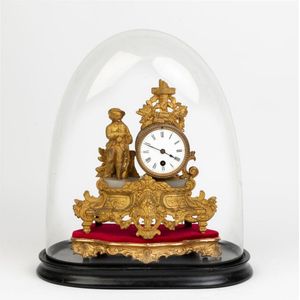Louis XVI Gilded Spelter Figural Mantel Clock with Hunter Figure
A Louis XVI gilded spelter figural mantel clock, French, circa 1870, depicting a hunter leaning on a sign reading 'Route/Chemin' beside a drum head with Roman numerals to an ornamented base, with red velvet giltwood stand, the movement numbered 4309, under dome, the clock 27.5 cm high, 27 cm wide, 11.5 cm deep, the dome 40 cm high, 37 cm wide
You must be a subscriber, and be logged in to view price and dealer details.
Subscribe Now to view actual auction price for this item
When you subscribe, you have the option of setting the currency in which to display prices to $Au, $US, $NZ or Stg.
This item has been sold, and the description, image and price are for reference purposes only.
- Movement - The technical name for the workings of a clock or watch, and does not include the dial or case.
- Giltwood - Giltwood is used to describe a gold finish on furniture and other decorative wooden items, whereby a thin sheet of gold metal, called gold leaf, is applied to the surface for decorative purposes.
Unlike gilding, where the gold leaf is applied over a coating of gesso, with giltwood the gold leaf is applied direct to the surface, or over a coat of linseed oil gold leaf adhesive.
Most gold-finished mirrors will be gilded, whereas furniture with gold highlights will have the gold applied through the giltwood method. - Gilding - Gilding is a method of ornamentation whereby a thin sheet of gold metal is applied to items made of wood, leather, ceramics, glass and silver for decorative purposes.
For furniture including mirrors, the sheet of gold is usually applied over a coating of gesso. Gesso is a mixture of plaster of Paris and gypsum mixed with water and then applied to the carved wooden frames of mirrors and picture frames as a base for applying the gold leaf. After numerous coats of gesso have been applied, allowed to dry and then sanded a coat of "bole", a usually red coloured mixture of clay and glue is brushed on and allowed to dry, after which the gold leaf is applied. Over time parts of the gilding will rub off so the base colour can be seen. In water gilding, this was generally a blue colour, while in oil gilding, the under layer was often yellow. In Victorian times, gilders frequently used red as a pigment beneath the gold leaf.
Metal was often gilded by a process known as fire gilding. Gold mixed with mercury was applied and heated, causing the mercury to evaporate, the long-term effect of which was to kill or disable the craftsman or woman from mercury poisoning. The pursuit of beauty has claimed many victims, not the least of which were the artists who made those pieces so highly sought after today. - Spelter - Spelter was the name given to an alloy of zinc and brass or copper used in the 19th century for statuary and lighting. It is a brittle bluish-white metal. It was used as a cheap replacement for bronze, but being brittle easily breaks and can't be repaired. When finished it can often be mistaken for bronze, but if discreet a scratch on the base displays shows a greyish colour, the metal is spelter, if a golden colour the metal is most likely bronze.
- Circa - A Latin term meaning 'about', often used in the antique trade to give an approximate date for the piece, usually considered to be five years on either side of the circa year. Thus, circa 1900 means the piece was made about 1900, probably between 1895 and 1905. The expression is sometimes abbreviated to c.1900.
This item has been included into following indexes:
-
clocks, type
- figural 706
- under glass dome 198
- meat covers / food covers / dish covers - pewter 1,609
